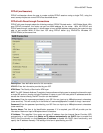
Billion 800VGT Router
PPPoE (multisession)
PPPoE multisession allows the user to create multiple PPPoE sessions using a single PVC, using the
exact same principles as normal PPPoE as described above.
PPPoE
with
Pass-through
Connections
PPPoE
with
pass-through
adopts
the
following
method:
PPPoE
Routed
mode
+
1483
Bridge
Mode.
With
pure
PPPoE
connection,
the
router
can
get
one
WAN
address
for
the
router.
With
the
PPPoE
and
PPPoE
pass-through,
concurrently,
it
allows
users
to
have
a
WAN
address
assigned
to
the
router
but
also
able
to
get
another
WAN
IP
from
their
ISP
using
PPPoE
dialler
(e.g.
WinPoETor
Windows
XP
PPPoE Dialler)
at
the
same
time.
Description:
User-definable
name
for
this
connection.
VPI/VCI:
Enter
the
information
provided
by
your
ISP.
ATM
Class:
The
Quality
of
Service
for
ATM
layer.
NAT:
The
NAT
(Network
Address
Translation)
feature
allows
multiple
users
to
access
the
Internet
through
a
single
ISP
account,
sharing
a
single
IP
address.
If
users
on
your
LAN
have
public
IP
addresses
and
can
access
the
Internet
directly,
the
NAT
function
can
be
disabled.
Username:
Enter
the
username
provided
by
your
ISP.
You
can
input
up
to
128
alphanumeric
characters
(case
sensitive).
This
will
usually
be
in
the
format
of
“username@ispname”
instead
of
simply
“username”.
Password:
Enter
the
password
provided
by
your
ISP.
You
can
input
up
to
128
alphanumeric
characters
(case
sensitive).
Service
Name:
This
item
is
for
identification
purposes.
If
it
is
required,
your
ISP
will
provide
you
the
information.
Maximum
input
is
20
alphanumeric
characters.
IP
Address
:
This
specifies
if
the
router
can
get
an
IP
address
from
the
Internet
Server
Provider
(ISP)
automatically
or
not.
Please
click
Obtain
an
IP
address
automatically
via
DHCP
client
to
enable
the
DHCP
client
functionality
or
click
Specify
an
IP
address
to
disable
the
DHCP
client
functionality,
and
specify
the
IP
address
manually.
The
setting
of
this
item
is
specified
by
your
ISP.
47
Chapter
4:
Configuration


















